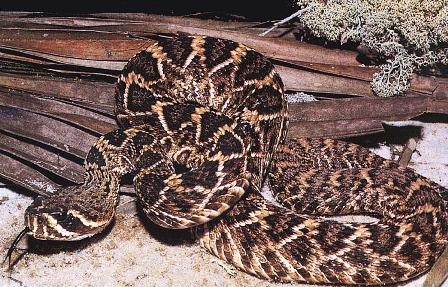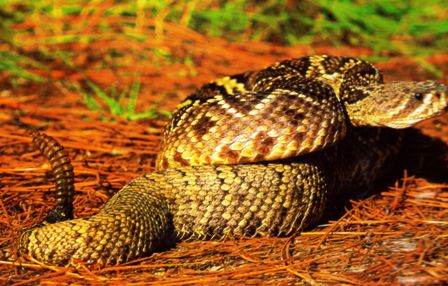Discover Florida Nature
It's time to explore the natural Florida


|
|
|
|
|
 A
majestic creature, the Eastern Diamondback Rattlesnake is the most
feared and dangerous snake in both Florida and the United States!
Diamondbacks are found throughout the state of Florida, including
several offshore islands and keys, and north along the coastal plain to
southeastern North Carolina and west to southern Mississippi and eastern
Louisiana. It's prime habitat is
pine flatwoods,
although it can occur just about anywhere, even in country towns and
city suburbs. These habitats contain palmetto thickets and
gopher tortoise burrows in which the
Diamondback may seek refuge. The eastern Diamondback Rattlesnake is a
heavy-bodied pit viper with a large triangular head. A
majestic creature, the Eastern Diamondback Rattlesnake is the most
feared and dangerous snake in both Florida and the United States!
Diamondbacks are found throughout the state of Florida, including
several offshore islands and keys, and north along the coastal plain to
southeastern North Carolina and west to southern Mississippi and eastern
Louisiana. It's prime habitat is
pine flatwoods,
although it can occur just about anywhere, even in country towns and
city suburbs. These habitats contain palmetto thickets and
gopher tortoise burrows in which the
Diamondback may seek refuge. The eastern Diamondback Rattlesnake is a
heavy-bodied pit viper with a large triangular head.
The Diamondback has an unmistakable yellow and dark brown pattern on it's back. All snakes lack ears, but no one is certain they are totally deaf. At any rate they are sensitive to vibrations of the ground. The average adult size of the Eastern Diamondback Rattlesnake is 36-72 inches, with the record length being 96 inches. The tail of the Diamondback is usually a different shade, brownish or gray, and toward the end of the tail the diamonds fade out or break into bands. The large and thick head has a light bordered dark stripe running diagonally through the eye and there are vertical light stripes on the snout. The pupil is vertical and catlike. The snakes venom is produced in glands which are located below and behind the rattlers eyes. These bulging glands, on either side of the head help give the head a triangular appearance. Like all pit vipers, there is a deep facial pit between the nostril and the eye. The facial pits are extremely sensitive heat-detecting organs, with which the rattler can home in on warm blooded prey. The pit organs can detect differences in temperatures as small as three one-thousandths of a degree centigrade! Pit vipers produce a hemotoxic venom that destroys the blood cells of both warm-blooded and cold-blooded animals. A blindfolded Diamondback can still strike accurately on it's target, guided by the remarkable sensitivity of its heat-detecting organs.  Rattlesnakes
have folding fangs which flip back against the roof of the mouth when
not in use. This design allows the fangs to be longer and deadlier than
if they were in a fixed position. As the snake opens its mouth to
strike, the fangs swing out. At the moment of striking, the
Diamondback's jaws are open very wide, and the fangs are pointing
forward toward the target.. The force of the snakes strike stabs the
fangs into the flesh of the prey. When a pit viper strikes, muscles in
its head squeeze venom out of the glands into small ducts that enter the
base of the fangs, which then enters the the victim through a small hole
near the tip of the fang. Eastern Diamondback Rattlesnakes replace their
fangs about every three months. Removing a pit vipers fangs will not
make it safe, since new fangs will grow to replace them. Rattlesnakes
have folding fangs which flip back against the roof of the mouth when
not in use. This design allows the fangs to be longer and deadlier than
if they were in a fixed position. As the snake opens its mouth to
strike, the fangs swing out. At the moment of striking, the
Diamondback's jaws are open very wide, and the fangs are pointing
forward toward the target.. The force of the snakes strike stabs the
fangs into the flesh of the prey. When a pit viper strikes, muscles in
its head squeeze venom out of the glands into small ducts that enter the
base of the fangs, which then enters the the victim through a small hole
near the tip of the fang. Eastern Diamondback Rattlesnakes replace their
fangs about every three months. Removing a pit vipers fangs will not
make it safe, since new fangs will grow to replace them.An Eastern Diamondback rattlesnake strikes at prey only when it senses that it can make a kill. It strikes at a predator only when it feels extremely threatened. The Eastern Diamondback usually needs to strike only once to achieve its objective. A rattlesnake can usually strike faster than the human eye can follow. The Eastern Diamond Rattlesnake can strike and recoil in 1/4 of a second! The Eastern Diamondback Rattlesnake preys on rats, mice, rabbits, and other warm blooded prey, many of which are considered pests. When threatened the Eastern Diamondback usually coils nosily, faces its intruder, hisses, and vibrates its rattles to create aloud pitched warning buzz. The rattler can strike accurately as far as half its body length and should never be approached more closely than about six feet. The Eastern Diamondback rattle is made of of a substance called keratin, similar to human fingernails. At birth, a rattlesnake has only a single button at the end of its tail. As the snake grows, another loosely interlocking segment is added each time it sheds its skin. A healthy rattlesnake might shed its skin and add another rattle as often as four times a year, but the snake can also have a few or even all of the segments break off from time to time, so it is an unreliable marker for guessing the age of the rattlesnake. The rattles are probably a protective device to scare away predators. |
|
|
Advertise | Privacy Statement | Dog Encyclopedia | Video |Contact | Alaska Nature |
|